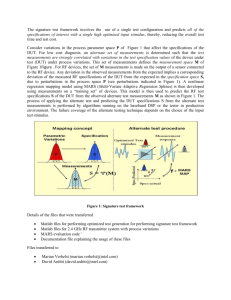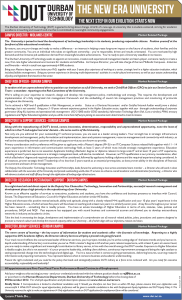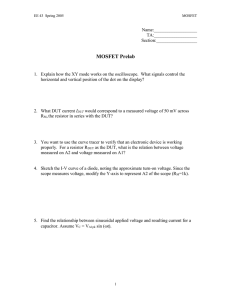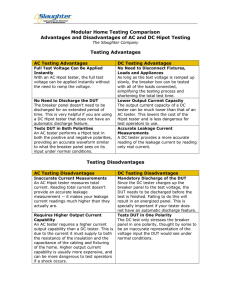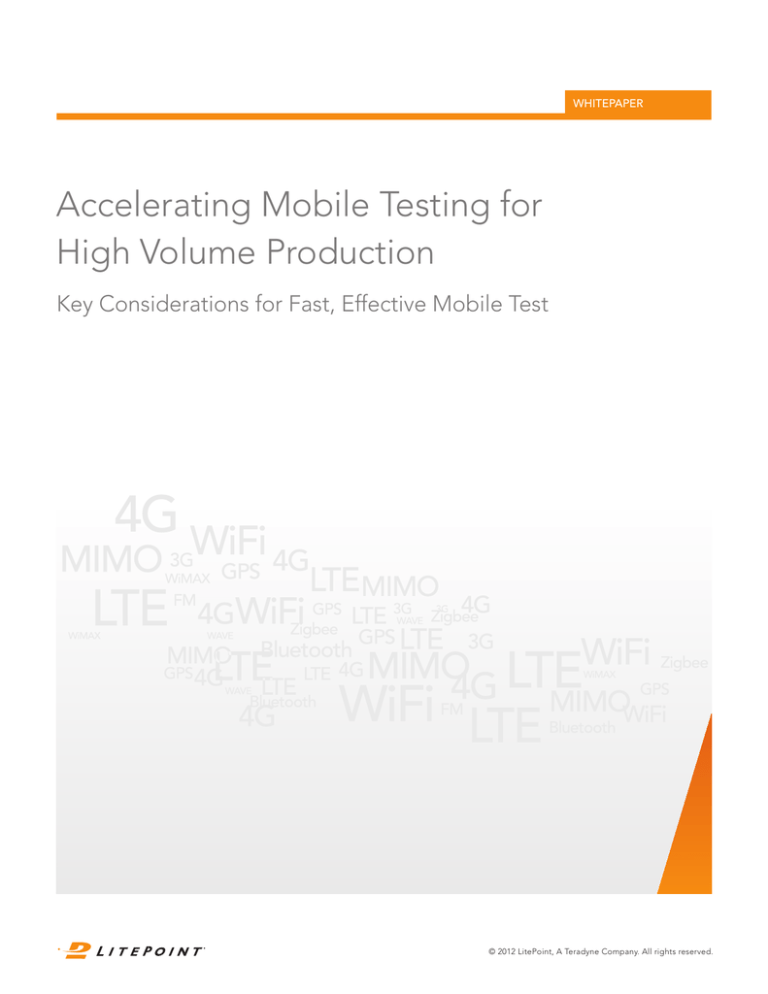
WHITEPAPER
Accelerating Mobile Testing for
High Volume Production
Key Considerations for Fast, Effective Mobile Test
© 2012 LitePoint, A Teradyne Company. All rights reserved.
Accelerating Mobile Testing for High Volume Production
Key Considerations for Fast, Effective Mobile Test
IQxstream® is a manufacturing oriented, physical
layer communication system tester representing a
fundamentally new value proposition when discussing
production test as compared to the more familiar
lab test environment. To fully leverage its capability
it is important to understand how it differs from the
lab testers available and why production test is very
different from lab testing.
This technical note will describe the differences
between a lab test environment and production
test. It will also describe some of the unique
advantages that a physical layer tester such as
IQxstream brings to the production floor.
WCDMA
LTE
GSM
1xEV-DO
TD-SCDMA
When implementing a production test solution,
there will always be a conflict between test
HSPA+
CDMA2000
coverage and manufacturing throughput.
The production floor manager wants to move
as many pieces per hour through test as he can. The quality manager wants to ensure that all defects are
detected and the CFO wants to support both but within the smallest capital budget possible.
Among the factors that need to be taken into account when designing a test system are:
•
Type of tester – physical layer vs. signaling
•
Tester speed – number of DUTs supported, measurement speed, configuration speed
•
Failure mechanisms in the DUT associated with manufacturing
•
Types and number of tests required
At the top of the list is the type of tester. It’s a very familiar path to take what the development engineers used for device design
and then replicate it in large numbers for production test. Too often, this results in a less than optimal solution from both a cost and
throughput perspective.
Lab Testers are fundamentally designed to support the design and system integration processes associated with the development
of a phone, tablet or laptop module. In this role they may perform physical layer, signaling and system testing. Beyond basic
design and troubleshooting, their measurements may be used for conformance, regulatory and regression purposes.
In a lab environment they may be integrated into a complex environment including
channel emulators and infrastructure simulators. They may operate under manual
control of a design/system engineer or they may be under computer control
executing complex test scripts, from physical layer tests, through signaling
performance to complex interference, fading and handoff scenarios, exploring every
nuance of a standard.
In these circumstances, ease of use, flexibility and top to bottom test capability of lab
testers take precedence. Test speed, instrument cost and the ease of integration into
a production environment are far down the list of priorities.
To a certain extent, lab testers are the multi-tools of testing. They are fun to pull out
of your pocket and can impress your friends but they cost a lot more than a dedicated
tool and really aren’t the most convenient when you have a focused task to perform.
Accelerating Mobile Testing for High Volume Production
2
Production Test is completely different from lab testing. The emphasis in production is to accurately determine if a mobile is
working in the absolute minimum time. With the emphasis on quality in today’s production lines, excessive or unnecessary testing
is an unjustifiable expense to find what few defects may exist.
In production the basic assumption has to be that the design handed off from engineering meets all the requirements of the
customer and when assembled correctly will do so consistently. Without this assurance, with today’s extremely complex devices,
the dimension of tests is simply too large to examine all the possibilities that might have escaped the design engineering process.
The production floor is not the place to be verifying millions of lines of firmware nor the hardware functionality associated with a
multi-million gate DSP/ASIC design.
The emphasis in production test is on finding manufacturing defects and the variability typically associated with the analog
components of the design. Is there a solder joint bad? Is a decoupling capacitor missing? Is the Power Amplifier yield high
enough? The digital functionality of a production unit is locked down in firmware and the ASIC/processor design. This digital
implementation drives all of the signaling and most of the signal generation and detection and does not change due to production
variances. It also should be noted that digital ICs are extensively tested as part of their manufacturing process and while circuits
that support the digital functionality may be damaged during module production, they usually will be fundamentally so, easy to
detect, often by the power up tests conducted by the phone itself.
The optimal production test focuses on physical layer measurements, the area that exhibits the greatest degree of variability
associated with the manufacturing process. Transmit power, the quality of the TX waveform, the accuracy of the TX frequency
are all key to the cell site’s ability to receive a mobile’s signal. On the RX side, the ability of the mobile to successfully decode the
received signal at the lowest and highest signal levels defines its successful operation in the network. These are all measurements
that are made by a physical layer tester.
So what role does signaling play in production test, given that it is fully proven out in the lab? The correct answer is very little. The
following section explores this in detail.
Signaling Driven Testing vs. the Terminal Interface
When conducting production test, it is necessary to put the DUT into a configuration in which a desired measurement or series of
measurements can be made. From a traditional air interface standard perspective, the logical way to do this is by emulating a base
station and sending signaling messages to the DUT.
This will involve the standard sequence of power up, system acquisition and then being ordered onto a channel in a particular
mode by the test equipment. In many cases getting to a given test state may involve stepping through a series of intermediate
states that conform to normal operation of the air interface. Each of these transitions will have their own signaling latencies none of
which add any value to the test case of interest. Unfortunately all of this is painfully slow as anyone who has pressed the call button
on their phone and waited for ‘ringback’, can attest to.
To speed things up, the faster way to get a DUT into a given state is to leverage its baseband data port. Virtually all mobile devices
built today have some means of connecting to their host processor typically via a USB port. Using this connection, the DUT can be
placed into a special test mode and commanded directly into the desired state. This is much faster than the back and forth of overthe-air messages and is supported by virtually all major IC manufacturers today.
This reliance on the terminal interface as opposed to signaling, in addition to being much faster, also makes for a simpler, more
reliable tester as it no longer has to conform to the upper layer signaling protocols and the potential variances of different base
station manufacturers.
Accelerating Mobile Testing for High Volume Production
3
Physical Layer Testers
Once we are able to directly command a mobile into a specific state, the need for signaling based testing is largely eliminated.
This has allowed wireless industry to define a new class of production test equipment known as physical layer testers. This is not to
say that physical layer testers do not support some degree of signaling but signaling is used sparingly in very specific cases since
physical layer testers generally do not support two way signaling dialogues.
Physical layer testers focus on measurements such as TX power, modulation accuracy and receiver performance. They do not worry
about the signaling dialog associated with sending an SMS or system level measurements such as hand-off performance.
Changing from a lab tester to a production physical layer tester is trading in the multi-tool and buying a box of screwdrivers. They
provide a lot more value for your money and those screws are going to go in a lot faster with a lot less fumbling.
IQxstream is the power screwdriver of the testing world. It increases the performance
by spinning the tool far faster than your hand ever could enabling test performance way
beyond that possible with lab testers.
IQxstream has been designed from the ground up to support fast, cost effective physical
layer testing. It is focused on detecting the variances as will be encountered in a production
environment and avoids the complexity, cost and performance penalties associated with typical engineering lab test equipment.
Decoupling Measurement from Analysis
Once you have made the decision to use physical layer testing to
evaluate a DUT in production, a number of other test performance
benefits are enabled.
Traditional Processing
Figure 1a
Conventional testing consists of a configure-capture-analyze
sequence as shown in figure 1a. Ironically the most expensive
component of a tester – the capture hardware – is the least used in
this model of measurement.
Most measurement in physical layer testing can be considered
static. This is not to say there is no time component to the
measurement but there is generally little or no back and forth RF
dialogue between the tester and the DUT. At best the tester (or the
DUT) generates a signal and the DUT does something in response.
There is no subsequent ‘response to the response’ so to speak.
Without the requirement to support an ongoing dialogue, there is
no need for real-time decoding of the signal in the tester.
Time
IQxstream Processing - Single DUT
Figure 1b
Time
IQxstream Processing - 4 DUT
This permits the tester to decouple the signal capture from the
analysis as shown in figure 1b. In this model, measurement becomes
a configure-capture model with analysis on a separate plane from
the capture activity. With analysis no longer part of the critical
path, the expensive capture hardware is more fully utilized and at
the same time, you are able to parallelize the analysis component
across general purpose multi-core processors.
DUT Configuration
Signal Capture
Signal Processing
DUT #4
DUT #3
DUT #2
The result is a much faster tester at incremental cost. This
change alone on a single DUT tester can lead to a 2x speed up
in processing.
DUT #1
Figure 1c
Time
Figure 1 – Decoupling Measurement from Analysis
Accelerating Mobile Testing for High Volume Production
4
The next step in this evolution is shown in figure 1c and is where IQxstream begins. By providing support for four DUTs, DUT
configuration can be parallelized and since capture is independent of analysis, DUT reconfiguration can begin immediately
following the last capture. Again, you get a significant gain in performance with only an incremental increase in cost.
The reader may make the comment that the test designer does not need to wait for completion of the capture for DUT #4 before
beginning the reconfiguration for DUT #1. This is certainly true however it is good practice in such an event to make sure the PA
is powered down during the reconfiguration process. The PAs for all the DUTs should only be turned back on once all previous
captures are complete. This is to insure that the DUTs do not interfere with each other during tests. For example, you will not want
to have a DUT transmitting at full power while trying to make measurements on another DUT at minimum power.
Sequence-based Physical Layer Testing – The Next Step
DUT testing typically takes place by commanding a DUT into a specific fixed configuration, and then a snapshot is captured from
its output. This process is repeated for each required configuration of the DUT, e.g., power settings, modulation type, etc. This
configure/measure sequence is shown in the upper part of Figure 2. While far superior to signaling-based DUT configuration, there
is still room for improvement.
In sequence-based testing, the DUT is preconfigured at setup with a given sequence of configurations and exactly how much time
to spend on each configuration. IQxstream then synchronizes its configurations and measurements to the changing configuration
of the DUT without any dialogue between the tester and the DUT.
While sequence-based testing depends upon the capabilities of the DUT, most IC manufacturers today support such testing. This
methodology can reduce test times by as much as 50% as shown by comparing the upper and lower portions of Figure 2.
Traditional Non-Signaling Test
DUT Configuration
IQxstream Sequence-Based Test
50%
Time Savings
Signal Capture
Load Sequence
Figure 2 – IQxstream Sequence-Based Testing Enables Significant Time Saving over Traditional Testing
This is another example of how a production-focused tester, such as IQxstream, can exploit innovative test techniques.
IQxstream’s unique architecture changes testing from being test-equipment limited, to DUT-speed limited – determined by how
fast the DUT can be directed to change to a new configuration. Reducing test times, while maximizing expensive data-capture
hardware utilization makes for the most cost-effective solution in the industry.
Accelerating Mobile Testing for High Volume Production
5
Capture Analysis
Another capability enabled by this type of testing is that once you have captured a block of data, there are multiple measurements
that can be calculated from it. For example from a single LTE capture you can calculate the following high level measurements:
•
Power
•
•
EVM
•
Occupied Bandwidth
•
ACLR
•
Spectrum Emission Mask
•
Frequency Error
Carrier Leakage
…and depending up on the DUT configuration
you may also be able to calculate:
•
TX Time Mask
•
In-band Emissions for Non Allocated Resource Block (RB)
The calculations happen independently from the data capture, not limited by capture speed and will have minimal impact on
overall test speed.
Using ‘Capture Once, Measure Many’ During Dynamic Power Measurements
As engineers we often think very linearly in terms of testing. What problem are we trying to detect? How do we test for it? Closed
loop power control is an example of this. Power control is critical to the proper operation of a mobile in the network so it is often a
critical component of any production test. The LTE Power Control Relative Tolerance tests not only exercise the mobile over the full
power control range, they also change the RB allocations over the range of 1, 25 and 50 during the test.
Normally one would assume that each one of the steps in the staircase and ILPC test would be a simple power measurement. By
expanding our focus beyond the simple TX power performance of the transmitter we realize that all of the TX measurements, from
Power to Spectrum Emission Mask could be made at each step providing a wealth of data without impacting capture time.
To avoid being overwhelmed by data, as a middle ground to calculating
a full set of measurements at each data point, the test engineer may
choose to be selective about what measurements get made at each
level.
Let’s use a hypothetical example to illustrate the power of this technique.
In the past, a particular PA manufacturer had at one point produced
devices that experienced linearity problems adjacent to particular
crossover points. If this was to escape the factory, these mobiles would
have erratic throughput when operating near these limits. The use of
EVM measurements as part of ILPC would guarantee that problem no
longer existed at zero cost to production test times.
Inner Loop Power Control Test
The result: customer assurance without impact to the production floor. Accelerating Mobile Testing for High Volume Production
6
Physical Layer Testing
So far we have discussed why a signaling approach to production testing is less than desirable but just what do we mean by
physical layer testing?
Physical layer testing focuses on the lowest layer of the air interface. It seeks to determine conformance with the key parameters
essential to the successful transmission of a signal over the air. Transmit power, the quality of the TX waveform, the accuracy of the
TX frequency, are all key to a mobile station’s performance. On the receive side, the ability of the mobile to successfully decode the
received signal at the lowest and highest signal levels defines its successful operation in the network.
Each air interface has its nuances however many tests will be the same or have analogous measurements. Often you will find the
names of a test will vary between the test specs of the various air interfaces but the following can be considered a representative
sample of physical layer measurements.
DUT Transmitter Measurements
Measurement
Discussion
TX Power
Performance on most modern air interface is highly dependent upon accurate power control across a wide
range of power settings and over rapidly changing channel parameters.
Error Vector Magnitude
This is the primary TX quality measurement. EVM detects distortions in the waveform that will ultimately
degrade the ability for the signal to be received accurately.
Frequency Error
Frequency accuracy is critically important to avoid interference on the uplink and for successful decoding at
the base station.
Adjacent Channel Leakage Ratio
ACLR is one of several measurements associated with not interfering with other users and systems. ACLR
measures undesired power in the immediate channel beside the working channel.
Occupied Bandwidth
Another measure of signal quality, this measurement confirms that the signal is being confined within its
required bandwidth.
Spectrum Emission Mask
This measurement insures that the signal in adjacent channels is falling off in a manner that
minimizes interference.
Carrier Leakage
This measurement looks for the presence of the carrier frequency on the output which is
normally suppressed.
TX Time Mask
This measurement looks at the signal in time, verifying that the PA is turning on and off at the correct time
without producing any extraneous signals. In most digital systems, being accurate in the time domain is just
as important as being accurate in the frequency domain.
Unlike the TX chain where the final output is presented at the antenna connector for evaluation, the RX signal remains buried
within the DUT until the signal is fully decoded. The fortunate part of this equation is that while there are many components in the
RX chain that can degrade, virtually all degradation will show up in a RX Bit Error Rate measurement at or near the RX threshold.
Physical layer testers are generally dependent upon the DUTs ability to report results on RX testing. Since RX quality monitoring
is a critical component of modern air interface operation, it is a straight forward problem to route this data to external terminal
interface. Most, if not all, IC manufacturers provide support for BER testing in one form or the other.
Accelerating Mobile Testing for High Volume Production
7
The following two tests are used to verify RX performance:
DUT RX Measurements
Measurement
Discussion
RX BER
RX BER is a fundamental test of a Receiver’s ability to decode the inbound signal. Typically this
measurement is made at the RX threshold and at a maximum input power.
RSSI
Receive signal strength is a parameter that is often measured as part of calibration. Since the initial
TX power level is calculated based on the measured RSSI, accuracy in a DUT’s RSSI measurement is
key to producing the right amount of power when first communicating with a base station.
Conclusion
In production test, the primary goal is to exercise the mobile as much as possible to identify manufacturing defects while
minimizing test time. The digital ICs have already gone through extensive testing during their production. The software and
digital designs have been proven during engineering and conformance testing. Digital failures, when they occur, will typically be
catastrophic resulting in the phone not powering up, not producing an output or not being able to receive a signal. Those that are
more subtle will typically show up in physical layer measurements. Therefore the optimal production tests focus on physical layer
measurements, the area that exhibits the largest degree of variability associated with the manufacturing process.
Physical layer measurements, allow decoupling of
the data capture process from the analysis process
making for optimized use of tester resources.
Leveraging the ‘capture once, measure many’ ability
of IQxstream has great benefits both in terms of
test speed but also overall test coverage. Sequence
based testing and Multi-DUT support extend the
performance gap even more vs. lab based testers.
DUT Test Time
(normalized)
Traditional
Signaling
Non-Signaling
LitePoint
Sequence-Based Test
Multi-DUT
All these capabilities merged together into the
IQxstream yields a greater than 10x improvement in test throughput. This increase capability can be used to both reduce test cost
and to expand test coverage as compared to traditional signaling, single DUT testers.
IQxstream represents a fundamentally new value proposition when discussing production test as compared to the more familiar
lab test environment. Its multi-DUT capability and ‘capture once, measure many’ capability combined with an architecture that
separates data capture from analysis makes for throughputs and flexibility never thought possible in a manufacturing environment.
Accelerating Mobile Testing for High Volume Production
8

